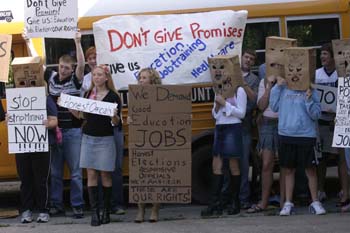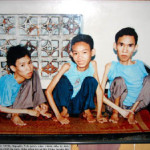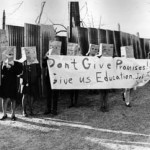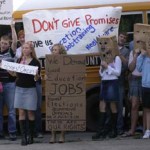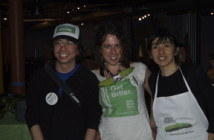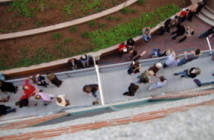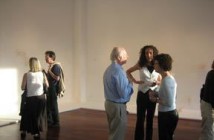On April 27th the Center for Advanced Visual Studies at MIT opened an exhibition of two projects by artists John Malpede and Harrell Fletcher with works that use reenactment as a strategy to bring historic events into the present tense.
Realized in 2004 in the context of a pivotal election year, Malpede’s RFK in EKY was a two-day site-specific performance of Robert Kennedy’s “poverty tour” of eight southeastern Kentucky towns in 1968. Transcripts and interviews from the actual events of Kennedy’s visit were studied for a meticulous re-creation that culminated in a performance by an all-local cast of hundreds. Their reenactments of official hearings on issues such as poverty, hunger and economic development underscored the striking inadequacies of American domestic policy, past and present.
Harrell Fletcher was on an artists’ residency in Vietnam when he came into contact with the War Remnants Museum in Ho Chi Minh City, a memorial museum for what is referred to there as The American War. Struck by the presentation of images from a Vietnamese perspective, after many visits he decided to photograph all of the documentation and captions in the main exhibition hall. His factual re-presentation of this foreign material in exhibition venues in the United States serves as a pertinent reminder of the casualties and fallouts of war. As with Malpede’s RFK in EKY, where community discussion of the events was given equal weight with the artwork itself, Fletcher initiated a number of public gatherings with talks by local people who had firsthand knowledge of the Vietnam war speaking of their experience.
Thinking of the exhibition, I was drawn to Walter Benjamin’s essay The Author As Producer, in which the critic replaces the tendentious question of the attitude of a political work with the more pertinent question of a work’s location. And it’s the actions of these works that speak louder than words: the partial perspective of the camera of an American trying to mediate the account of an atrocity from the perspective of its recipients; the notion of a moment of hope shared and examined again by the impoverished community that felt its first presence. The distance collapsed in these works revives history from abstraction and makes if a living concern. I was pleased to be able to talk with John Malpede and Harrell Fletcher about their work at CAVS.
Jason Schiedel: The freedom to make things as art that did not resemble art is a radical idea from the sixties that both of you take up in different ways. One could argue that the critique of traditional art forms initiated by minimal and conceptual art is today simply interpreted as the permission to include any and all possible activities as art; even as critical art. Are you consciously working in terms of an expanded definition of art, or is art’s status something negligible to you? What part of the art context do you retain and foreground? Do you find it too limiting a term?
John Malpede: I’m looking at how to construct something that could have the most effect. When I was working on RFK in EKY [a site-specific, real-time reenactment of Robert F. Kennedy’s 1968 200-mile “poverty tour” of southeastern Kentucky, involving members of those communities], I had this involvement with Head Start [a federal government school-readiness program for inner city children], and as a result of that I was asked to do something further with them. Then once we started working with them and started organizing community conversations, although we did some theatre stuff, it was all still in the context of generating that bigger conversation. What’s interesting to me about that project is not so much the theatre component, although it could be very powerful given more time. It’s the effectiveness of generating conversations in the community and how you link that to advocacy. It’s the process of making change by doing grass roots organizing, but also connecting to the people who make the decisions and putting effective pressure on them. I wouldn’t consider that an art activity but it’s what is most interesting to me about that project. I want community organizing and advocacy to inform future art projects, and the more I can incorporate them the happier I will be.
The other thing I’d say is that when I studied philosophy in school two of the people I was most interested in were Wittgenstein and Simone Weil, both of whom were people who kept giving up their identities as philosophers to do other stuff. Wittgenstein wrote the Tractatus, and then he quit philosophy and taught primary school and designed houses, and 20 years later came back and wrote a book that refuted his first book. Simone Weil quit teaching and went to work in a Renault factory, and pick grapes, because she had a social concern and she wanted to find out first hand about what was going on. What I’ve said before is that what was cool about those people is that they were quitters. Having your identity slightly in flux is really important; or being willing to let go of your identity and maybe assume a new identity. Now I’m sort of stuck in this artist identity, but that it can range into things that are not art and that maybe I don’t even consider art, and that I can put a lot of investment in that and then recycle it back into my artist identity is important.
Harrell Fletcher: If art was treated in my ideal scenario it would be, “you can do whatever you want,” so you don’t have to worry about the categorization of it. Then, quitting doing something and going to work in a Renault factory would be fine because that’s still part of your practice.
JM: I think it really is. It’s not quitting; it was part of [Weil’s] practice. It’s what made her practice exceptional.
HF: I was just at the University of Minnesota, and there’s this new movement going on of trying to create not inter-disciplinary departments but an anti-disciplinary department. There’s no, “this is art merging with,” just, “forget the disciplines, let’s just be generalists here. We do what we need to do, as we need to do it, having developed a sensibility or an approach. This is my practice as a person doing things in the world.” So I think that’s interesting; I mean it’s useful for me.
Whenever someone presents me with a limited definition of what art should be, my question is always, well, what is being served by that definition? What do you get by saying, “this is the border of art; it is these things?” And there’s never any good answer to that. The main answer that people ultimately come up to once they work through it a bit is that it allows a rarefication to happen that ultimately serves the function of commercial interest. If you can rarefy something and say, “this is art; these materials; this way,” then you can also sell that thing as art. And at that point you’re taking out the more complicated view of whether or not it’s art, and just saying, “it’s valuable.” Instead you have to say, “Well, what is the thing?” Let me just deal with the thing and see what’s interesting or not interesting about it, without some sort of categorical dropping of value on top of it.
JM: One thing I have been saying recently is that the artist’s job is to confuse the categories. That was what Duchamp was talking about.
JS: It also has a lot to do with the notion of the audience. Both of you are addressing a very specific audience, sometimes using the audience as part of the work. I feel like a lot of artists, when they use a term like the viewer, have a very unspecified notion of who the viewer might be. The viewer might be a cross-section of the public, like the movie-going public. There’s a notion of trying to get it out to the broadest amount of people possible. But your audiences are both very specific. Do you feel that it’s through specificity that they then become accessible for a larger audience, or in fact, do you feel that the work is for a small amount of people?
HF: I generally think in opposite terms. That when artists or galleries are thinking of their viewers they’re usually thinking of an art viewer, the people who go to see things in the rarefied spaces of galleries or museums, and that those people are supposed to be educated to a certain point, and bringing with them some kind of information so that they can access that work. Those are the ones that count. When the person’s working away in their studio that’s what’s in the back of their mind: “I know where this goes. The thing I’m making is supposed to go into a Chelsea gallery on its way to a museum or collector’s house, and those are the viewers that I’m concerned about.” And actually they might say, “I don’t care about the viewer. I’m making this stuff for myself.” Which, none of that stuff makes much sense to me. For the most part, that’s not going to happen to the majority of people working away in their studio, so why not have a different point of view and think of a different potential audience for whatever your activity is as an artist? For me, I’ve wanted to do something that is more accessible to a broader kind of audience than that one. I sort of figured I’m already in an art context so I can probably get those art people pretty easily. Now how do I go about getting a broader set of people? And through various projects over the years I’ve wound up with much broader non-art kinds of audiences, often times interacting with art audiences in the same kind of form. And that’s always been interesting to me. One of the ways of doing that was by making the subject of the work really specific and sometimes directly connected to the audience I was trying to broaden out into. To create an investment that those people would have in that thing, and then bringing that to the normally rarefied space of the gallery. [For instance, Fletcher asked 25 art-related people to invite someone they knew to talk about a topic of their choosing for 10 minutes at an all-day event at Apexart gallery in New York. These “sessions,” called Come Together, take on different configurations depending on where they are taking place.]
JM: The stuff that I work with, LAPD [founded by John Malpede in 1985, the“Los Angeles Poverty Department,” is a long-running series of workshops and performances by and for homeless members of the Skid Row community in downtown Los Angeles], and RFK in EKY, obviously, are located in a particular community and they try to be very specific about those communities. Sometimes it’s exclusively about the community making something for the community in the community. But other times it’s very much about getting the word out to Normalville, as Sunshine [an original member of LAPD]once said in a performance. We try to get outside of the community because that’s been a very isolated, socially constructed area. So the idea is to have an insider’s view of that community and then present it in a way that goes beyond the community, if possible. A lot of times we try to site the performance in such a place where we’ll get a mixture of audience. Creating an interaction, and bringing different parts of the social geography together is sometimes a really important part of the project.
JS: In a way that reminds me of your position on the question of art, which is to confuse the definition of art, or to complicate the notion of what an artist is. I think the way you’re talking about audience is very similar: you complicate the notion of the audience.
JM: It goes back to what Harrell was talking about when he was in Vietnam, how he suddenly saw that what we call the Vietnam war is called the American war over there. Because of all the fragmentation, and the different points of view about life here and about life somewhere else, creating a context where these views can rub up against one another is important.
JS: I have a question for you on the subject of progress. Ever since Post-modernism we’ve called into question the idea of progress, or the notion of linear progression, yet we are still living in a time when we’re focused on the effects of improvement: we’re more technologically sophisticated; we can extend the average life expectancy of a person. The notion of progress is still a very alluring, powerful idea. I think in a lot of these pieces, particularly in the re-creation that John was doing in Kentucky, this notion is blown apart because you bring the past and the present face to face, showing how things that were problems 40 years ago are aggravated problems today. Do you parlay that critique of progress into a vehicle for a work? As an artist I’m always trying to define when I feel I’ve attained success in a work. One of the successful effects that resonate in this work is a kind of demonstration in lived experience that works against a simple notion of progress.
JM: I don’t think so much in terms of progress, but I do think of what we mean when we say that we live in the greatest democracy in the world. Basically, if we live in the best society, somewhere embedded in that is the idea of progress. So I think that what Harrell’s project and RFK all call into question, is that if we killed 3 million people and maimed a gazillion more and ruined the earth, that this sort of problematizes this notion that we’re the greatest democracy in the world. I’m not reacting so much to the notion of progress, but as my friend Peter Sellars said once, every now and again the United States just announces that they’re going to eradicate something, just through the sheer application of enough force and violence. This is what the notion of progress is, in a certain sense: that we can eradicate the belief structure and the social structure of the Middle East and reshape it in our own image. That’s progress because we are the greatest and have the greatest insight into what should be.
HF: I don’t know if I’m lucky or if I’m just really loose in my definition of success, but I rarely run into something that I feel was unsuccessful. Usually there’s something great that comes out of an event. Even if an event happens and ten people show up as opposed to three hundred people showing up. I try and not think on a vertical line of what success is, or that I’m passing through things. That if I show in the Whitney Museum then I shouldn’t show back on the streets in Portland. I want to make it horizontal. The fact that I’m continually trying to put things on the same level does in some ways undermine the normal concepts of what success is and what the concept of progress might be too. But at least as an artist I’m not progressing in a traditional sense…
JS: You’re not progressing up; you’re progressing out?
HF: Yeah, kind of like that. And going back and forth to whatever the origins were, not letting go of one thing to move onto the next like a stepping stone process, but creating this wider field where you can run all over the place. By showing The American War I’m also trying to say yeah, look, we haven’t really progressed that much in the last 30 years. Vietnam happened and it seemed like we learned something from it, then it turns out we didn’t and we’re doing it all over again. What they learned was media management, not any sort of moral or diplomatic skills. So I’m happy to point those things out.
Often times people ask me about having some sort of utopian ideals, which I don’t really relate to, because I’m not interested in utopias. I’m not interested in illustrations of some perfect world. I’m interested in what we can do right now, whether it’s shifting your perspective on success, or shifting your perspective on what should be valued in the world, or actually making social change to a certain extent. I’m just into the reality of those things, not the utopian vision of what those things could be. And trying in my own little way making the things happen that I think would be interesting to have happen.
JS: One aspect of the work that I remember you talking about when you were here in February is a feeling of inclusiveness and affirmation. You talked about the use of art for focusing attention on something, or of using the status of art to raise something to the level of attention. I’m wondering if the two recent projects, the Humans at War piece that you did in Wisconsin, and the American War now, if you consider this to be a departure or new direction for your work because it certainly seems to involve a really different range of feelings than the previous work admitted. If the other works called attention to agency, then these recent pieces talk about the consequences of agency in a really different modality. [In Humans at War HF had students at the University of Wisconsin talk to someone they knew who had first-hand experience of war, and work with that person in producing a drawing that accurately reflected that experience. The students also did research about war-related books in their public library and produced advertisements for those materials, which were then canvassed across the campus and the community.]
HF: Yeah, this is something I’ve been trying to think about and people have brought it up in various forms: that these recent projects are a little bit different. Earlier on I felt, partly because a lot of artists chose to use dark subject matter as a way to bring attention to their work, it felt like it could be a cheap shot, and I wanted to avoid that. I thought, all right, I’m already dark enough on my own; I’m depressed enough. I’m going to look for things that are about other feelings besides that. So early on there was a trying to steer clear of the depressing things, although these things always came up. There were gentrification issues, race issues, and lots of things that have come up through the work. My thought on that was these things are part of life. People have scars, people get hurt, people have good times, all of these things happen. And I didn’t really want to differentiate them value-wise.
I never start with an issue. I didn’t start with the issue of gentrification, doing early projects in a neighborhood that was being gentrified. Instead, I just worked with people and sometimes that would come up as part of the projects that I’d do. So even though I’ve been really disturbed about the current situation politically, I wasn’t sure what to do about that as an artist. Stumbling upon the museum in Vietnam wasn’t any different than the way I stumbled across anything else that I’ve done in the past. It happened to be about these things, and there was this synchronicity with what is going on now in Iraq. But I didn’t seek it out, really.
The reason that the project Humans at War occurred was that I was working on The American War, and that’s what I was engaged with. So when I was asked, okay you have four days to work with some students in Wisconsin, what do you want to do? All I’m doing and thinking about at the time is war-related stuff; so it’s like, well let’s go do some research on war. It’s hard to tell what’s going happen from that, where I’m going bring that to next. That’s what opens me up, too. I am glad that there is this expanding of the potential for what I can work with. I think that doing these projects has been a huge education for me in a bunch of different ways that I’m really glad has occurred.
Links:
MIT Center for Advanced Visual Studies
"JOHN MALPEDE: RFK IN EKY " & "HARRELL FLETCHER: THE AMERICAN WAR" is on view April 27–June 9 at The MIT Center for Advanced Visual Studies.
All images are courtesy of the artists.

